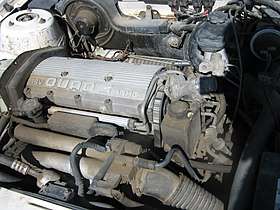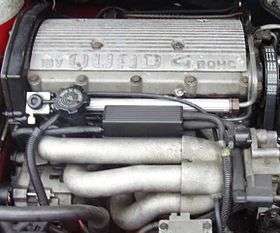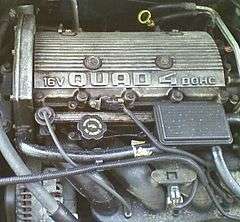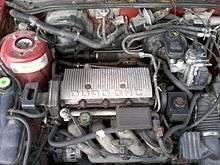Quad 4 engine
The engine family known as the Quad 4s was debuted to the public in the spring of 1987. The Quad 4 is a 2,260.5 cc (2.3 L; 137.9 cu in) DOHC inline four-cylinder produced by General Motors' Oldsmobile division. The Quad 4 name is derived from the engine's four-valve, four-cylinder layout. The engine was a modern design for its time, using a cast-iron block and an aluminum head. Even though belts were more popular for this purpose on OHC engines at the time, chains were used to time the camshafts to the crankshaft. The water pump is also driven by the timing chain. The Quad 4 was the first wholly domestic regular production DOHC four-cylinder engine designed and built by GM; the only prior DOHC four-cylinder engine offered by GM was the Cosworth Vega, which featured a DOHC head designed by Cosworth in England.
 | |
|---|---|
 | |
| Overview | |
| Manufacturer | Oldsmobile division of GM |
| Also called | Twin Cam or Quad OHC |
| Production | 1987-2002 |
| Layout | |
| Configuration | Straight-4 |
| Displacement |
|
| Cylinder bore |
|
| Piston stroke |
|
| Block material | Cast iron |
| Head material | Aluminum |
| Valvetrain |
|
| Compression ratio | 9.5:1, 9.7:1, 10.0:1 |
| Combustion | |
| Turbocharger | On some versions |
| Fuel system | Sequential MPFI |
| Fuel type | Gasoline |
| Oil system | Wet sump |
| Cooling system | Water-cooled |
| Output | |
| Power output | 150–190 bhp (112–142 kW) |
| Torque output | 160 lb⋅ft (217 N⋅m) |
| Chronology | |
| Successor | Ecotec engine |
First released to the public as a regular production option for the 1988 Oldsmobile Cutlass Calais and Pontiac Grand Am, the engine's availability expanded to Buick in late 1988 and Chevrolet in 1990, after which it became a mainstay in GM's lineup until its cancellation after the 2002 model year.
Simultaneous to the engine's release in 1988, Oldsmobile attempted to further the Quad 4 name through highly publicized events featuring such cars as the Oldsmobile Aerotech. Another such event was the 1988 Indianapolis 500, when Oldsmobile was chosen to pace the race with a convertible version of their Cutlass Supreme, and a pre-production turbocharged Quad 4 was the engine of choice for their pace car. Although it was publicized in 1988 that the Quad 4 was forthcoming in a 180 bhp (134 kW) "HO", as well as a 250 bhp (186 kW) turbocharged version (the same engine that was in the pace car that year), GM never released the turbocharged version as a publicly available option. Although the engine in Oldsmobile Aerotech was a purpose-built, turbocharged example; it was solely meant to showcase the capability of the engine's design.
After the first few years of positive reviews of the Quad 4, the automotive press began to criticize it for its noise, vibration, and harshness levels. At the time, the Quad 4 was generally compared to turbocharged four cylinders, V6s, and occasionally V8s. The first changes of the Quad 4 to address its NVH were two rounds of exhaust port size reductions, followed by the addition of balance shafts in 1995. Further changes were made for the 1996 model year when the engine's bore and stroke were changed, and the engine was subsequently redubbed "Twin Cam".
In addition to the 2,260.5 cc (2.3 L; 137.9 cu in) DOHC versions, there was also both a short-lived SOHC variant, the "Quad OHC", available from 1992 to 1994, and the 2,392.3 cc (2.4 L; 146.0 cu in) Twin Cam from 1996 to 2002. The Twin Cam was replaced by the Ecotec for the 2003 model year.
All engines in the Quad 4 family were produced at the Lansing Engine Plant (plant five) in Delta Township near Lansing, Michigan. The Twin Cam was the last engine that was engineered and produced solely by Oldsmobile; the Aurora V8 and Intrigue V6 shared architecture with the Cadillac Northstar.
In recent years, the design has gained a minor following in hot rodding circles as a period style engine because it looks similar to a 1930s Offenhauser DOHC design (once you remove the ribbed aluminum cover, exposing the tall "cam towers" and the deep valley between them holding the spark plugs).[1][2]
LD2

The LD2 was the standard version of the Quad 4, and the first incarnation was introduced in 1987 for the 1988 model year. In base form, the Quad 4 put out 150 bhp (112 kW) from 1988 to 1989 and 160 bhp (119 kW) from 1990 to 1992. GM was able to produce the 160 bhp (119 kW) with neither a turbo, nor an EGR system to pass emission standards; it required a 9.5:1 compression ratio. The base Quad 4 saw several slight changes during its production run including different crankshafts, cams, and manifolds, all meant to increase torque and lessen the NVH. In an effort to yield 5 additional HP some highly opted 1992 RPO LD2 SC Oldsmobile Achievas received a vortex valve along the TB induction pipe runner with an injection molded auxiliary induction tube funneling cool air from outside the engine compartment to the airbox via the openings around drivers side headlight (ram/air replete with cold weather block off plate in radiator core support) as until the engine warmed up would cause stumbling issues with the MAF sensor. There was also a transitional version of the LD2 in 1995, which displaced the same 2.3 litres (2,260.5 cc) as the early Quad 4 but featured the dual balance shafts of the later quipped 2.4 L (2,392.3 cc) LD9 Twin Cam.
Applications:
- 1988–1991 Buick Skylark
- 1992–1994 Oldsmobile Achieva
- 1988–1991 Oldsmobile Cutlass Calais
- 1990–1991 Oldsmobile Cutlass Supreme
- 1988–1994 Pontiac Grand Am
- 1990–1991 Pontiac Grand Prix
- 1993–1997 Pontiac Trans Sport (Europe only)
1995

For 1995 only, a balance shaft-equipped version of the 2.3 L (2,260.5 cc) version was produced. This arrangement ensures a constant load on the shafts: the crank drives one shaft, which drives the second, which then drives the oil pump. The shafts spin at twice the engine rpm, forcing the redline to be reduced from 6800 to 6500 rpm. Output is 150 bhp (112 kW) and 150 lb⋅ft (203 N⋅m). This was the only Quad 4 produced in 1995.
This was known as a transitional year for the engine family.
Applications:
- 1995 Pontiac Sunfire GT
- 1995 Chevrolet Cavalier Z24
- 1995 Pontiac Grand Am
- 1995 Oldsmobile Achieva
- 1995 Buick Skylark
LG0
The "high output" 2.3 L (2,260.5 cc) LG0 was rated at 180 hp (134 kW) from 1989 to 1992, 175 hp (130 kW) in 1993 and 170 hp (127 kW) in 1994; both the 1993 and 1994 power reductions were a direct result of the first two rounds of the Quad 4's NVH reductions; both being exhaust port size reductions. Changes that differentiate the LG0 from the LD2 engine are more aggressive camshafts and an extra half point of compression; 9.5:1 to 10.0:1. These engines were recommended to run exclusively on premium fuel with a 91 octane rating or higher due to the compression ratio.
The high output engine was introduced with both a special production run of 200 Cutlass Calais International Series coupes, as well as 200 Grand Am SE coupes — all featuring bright red paint, and gray interiors. The LG0 engine was only available with the heavy-duty Getrag designed HM-282/NVG-T550 five-speed manual transmission.
From 1989 to 2009, the Quad 4 held the title of being General Motors' most powerful naturally aspirated regular production four-cylinder engine (with the exception of the 2.92L I4 Atlas engines used in 2007-2012 Chevrolet Colorados and GMC Canyons). Only recently was the LG0's 180 bhp (134 kW) rating eclipsed when the 2010 model year 2.4 L (2,392.3 cc) Ecotec LAF was launched in the Buick Lacrosse and Chevrolet Equinox. The LAF has a rated output of 182 hp (136 kW) but does so with an 11.4:1 compression ratio, gasoline direct injection and variable valve timing.
There was a limited production version of the LG0 engine offered in select Oldsmobiles which used the designation "W41" (listed below).
LG0 applications:
- 1990–1993 Chevrolet Beretta GTZ
- 1994 Chevrolet Beretta Z26
- 1989–1991 Pontiac Grand Am SE
- 1990–1991 Pontiac Grand Am LE with the "sport performance package" (RPO: W32)
- 1992–1994 Pontiac Grand Am GT
- 1989–1991 Oldsmobile Cutlass Calais International Series
- 1990-1991 Oldsmobile Cutlass Calais Quad 442
- 1992–1994 Oldsmobile Achieva SC
- 1990 Oldsmobile Cutlass Supreme International Series
W41

The W41 was the highest-output Quad 4. The 1991–1992 W41s were rated at 190 hp (142 kW), while the 1993 W41 was rated at 185 hp (138 kW) as a result of the first round of exhaust port size reduction to improve emissions and other changes to the Quad 4 architecture to reduce NVH. The additional 10 hp (7 kW) came from longer duration cams and a different PROM. Part of the W41 drivetrain was a specific version of the HM-282/NVG-T550 with a gear set otherwise unavailable. All W41 five-speed transmissions had a final drive ratio (FDR) of 3.94:1 whereas the 1988–1992.5 LD2 and LG0 transmissions all used a 3.61:1 FDR; the 3.94:1 FDR was used on all 1992.5-1994 LG0 transmissions, but retained the standard HM-282/NVG-T550 gear set.
W41 applications:
- 1991 Oldsmobile Cutlass Calais
- 1992–1993 Oldsmobile Achieva SCX
L40

A SOHC variant of the Quad 4 was intended to replace the Pontiac 2.5 L Tech IV OHV "Iron Duke" engine. Debuting in 1992, this Quad OHC was an eight-valve engine and produced 120 hp (89 kW), 40 hp (30 kW) less than the Quad 4 of the same era. Torque was 140 lb⋅ft (190 N⋅m). Power dropped to 115 hp (86 kW) in 1993 with an attempt by GM to reduce the NVH of the engine.
Although power and fuel economy were better than the Tech IV, the Quad OHC was retired after 1994 when the DOHC version became standard.
Applications:
- 1992–1994 Oldsmobile Achieva
- 1992–1994 Pontiac Grand Am
- 1992–1994 Buick Skylark
LD9

The LD9 Twin Cam was a 2.4 L (146 cu in) Quad 4 variant with balance shafts, and a redesigned cylinder head which debuted in 1996. In the mid-nineties, these engines, like their earlier 2.3L counterparts, were known for timing chain failures, as well as water pump failures, in which the water pumps were often difficult and costly to access and replace. They also had very small oil passages, making for less than adequate lubrication, and costly engine repairs if not maintained properly. Bore was decreased from 92 to 90 mm (3.62 to 3.54 in) and stroke increased from 85 to 94 mm (3.35 to 3.70 in) for better torque. Power came in at 150 bhp (112 kW).[3] This engine received a minor update halfway through the 1999 model year that eliminated the exhaust gas recirculation, increased the compression ratio from 9.5:1 to 9.7:1, and switched from low impedance fuel injectors to high impedance. For increased reliability this engine also saw other minor updates in the 2000s towards the end of its use in General Motors vehicles. In 2001, changes included a smaller knock sensor, flat-top pistons instead of dished, new oiling passages, newer stronger timing chain, a newer-designed water pump, a redesigned starter motor and a higher capacity catalytic converter. An improved belt tensioner was introduced in 2002.
Specifications post-1999
| Engine type | Inline 4-cylinder DOHC 16v |
| Displacement | 146 cu in (2.4 L) |
| Bore | 90 mm (3.54 in) |
| Stroke | 94 mm (3.70 in) |
| Compression ratio | 9.7:1 |
| Fuel delivery | Sequential fuel injection (SFI) |
| Peak power | 150 hp (112 kW) at 5600 rpm |
| Peak torque | 155 lb⋅ft (210 N⋅m) at 4400 rpm |
| Estimated fuel mileage | 23 mpg‑US (10 L/100 km; 28 mpg‑imp) city / 33 mpg‑US (7.1 L/100 km; 40 mpg‑imp) highway |
Applications:
- 1996–2002 Chevrolet Cavalier Z24
- 1996–2002 Pontiac Sunfire GT
- 1996–2001 Pontiac Grand Am
- 1996–1998 Oldsmobile Achieva
- 1999–2001 Oldsmobile Alero
- 1997–2000 Chevrolet Malibu
- 1996–1998 Buick Skylark
Racing
- Very early experimental racing engine
- 900 hp (671 kW) - rear. Single turbocharger.
- 900 hp (671 kW) - side
Applications: Oldsmobile Aerotech
References
- "Street Rodder Article August 2006". Streetrodderweb.com. Retrieved 2012-06-04.
- "Street Rodder Article March 2007". Streetrodderweb.com. Retrieved 2012-06-04.
- "1996 Cavalier Specifications - (continued)". Media.gm.com. Archived from the original on May 11, 2004. Retrieved 2009-04-26.